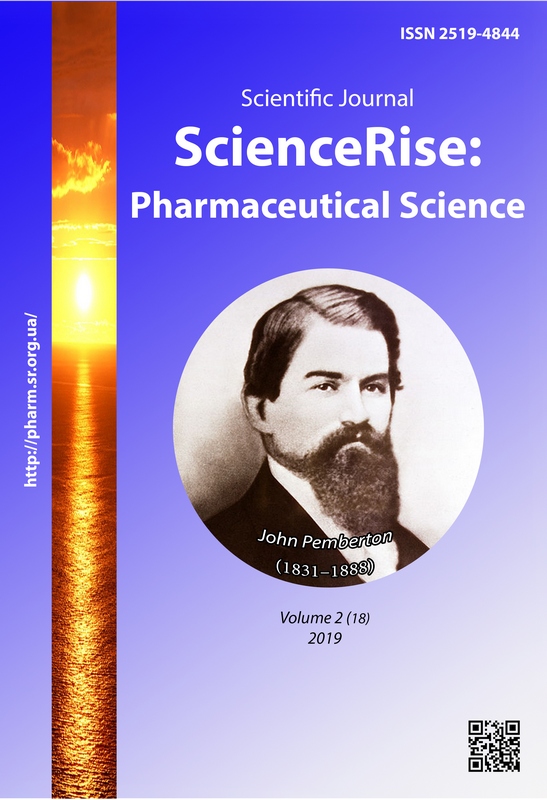Β-лактамні антибіотики в Україні: аналіз ринку та споживання у 2013–2018 роках
DOI:
https://doi.org/10.15587/2519-4852.2019.165682Ключові слова:
фармацевтичний ринок, β-лактамні антибіотики, споживання лікарських засобів, ATC/DDD-методологіяАнотація
Стратегія боротьби проти розвитку антибіотикорезистентності – глобальний виклик для наукової спільноти задля життя і здоров’я населення. Аналіз взаємозв’язку між рівнями споживання антимікробних препаратів та розвитком антибіотикорезистентності – один з інструментів стримування останньої. Збільшення споживання антимікробних препаратів знижує можливості лікування інфекційних захворювань.
Антимікробні препарати групи β-лактамів, за даними звітів Європейської мережі нагляду за споживанням антимікробних засобів, є одними з найбільш споживаних серед інших груп антибіотиків у Європі. В Україні рівень споживання β-лактамів значно нижчий середньоєвропейського. Такі дані вимагають детальної оцінки рівня споживання β-лактамних антимікробних препаратів, за окремими МНН, аналізу балансу їх застосування.
Метою роботи є аналіз ринку та споживання АМП групи β-лактамів в Україні за 2013-2018 роки за допомогою ATC/DDD-методології, а також порівняння отриманих об’ємів споживання з аналогічними результатами в Європейському Союзі.
Результати. Загальна кількість АМП групи β-лактамів представлених на ринку України у 2018 році становить 343 торгових найменування (ТН), з них – 92 пропозиції вітчизняних і 251 – іноземних фірм-виробників, що свідчить про високу насиченість українського фармацевтичного ринку імпортними препаратами
В Україні у 2017 році пеніцилінів спожито у 4,48 разу менше ніж у середньому по ЄС, а цефалоспоринів та карбапенемів майже стільки ж.
Найбільше було спожито препаратів МНН з групи пеніцилінів – Амоксициліну та Амоксициліну з інгібіторами β-лактамаз, а лідерами за об’ємами споживання серед цефалоспоринів є лікарські засоби за МНН Цефтріаксону і Цефуроксиму.
Висновки. Антимікробні препарати групи β-лактамів добре вивчені та широко використовуються у медичній практиці, в асортименті представлені на ринку України (343 ТН), але тільки менше третини з них (92 ТН) – вітчизняного виробництва, що свідчить про високу насиченість українського фармацевтичного ринку імпортними препаратами. Об’єм споживання антимікробних препаратів групи β-лактамів в Україні майже в 4,5 рази менший, ніж у країнах ЄС.
Найбільш споживаними є препарати Амоксициліну – групи пеніцилінів широкого спектру дії та серед цефалоспоринів – препарати Цефтріаксону та Цефуроксиму
Посилання
- Bennett, J. W., Chung, K.-T. (2001). Alexander Fleming and the discovery of penicillin. Advances in Applied Microbiology, 163–184. doi: https://doi.org/10.1016/s0065-2164(01)49013-7
- Chellat, M. F., Raguž, L., Riedl, R. (2016). Targeting Antibiotic Resistance. Angewandte Chemie International Edition, 55 (23), 6600–6626. doi: https://doi.org/10.1002/anie.201506818
- Van Loon, K., Voor in ‘t holt, A. F., Vos, M. C. (2017). A Systematic Review and Meta-analyses of the Clinical Epidemiology of Carbapenem-Resistant Enterobacteriaceae. Antimicrobial Agents and Chemotherapy, 62 (1). doi: https://doi.org/10.1128/aac.01730-17
- Bell, B. G., Schellevis, F., Stobberingh, E., Goossens, H., Pringle, M. (2014). A systematic review and meta-analysis of the effects of antibiotic consumption on antibiotic resistance. BMC Infectious Diseases, 14 (1). doi: https://doi.org/10.1186/1471-2334-14-13
- Baditoiu, L., Axente, C., Lungeanu, D., Muntean, D., Horhat, F., Moldovan, R. et. al. (2017). Intensive care antibiotic consumption and resistance patterns: a cross-correlation analysis. Annals of Clinical Microbiology and Antimicrobials, 16 (1). doi: https://doi.org/10.1186/s12941-017-0251-8
- Use of ATC/DDD. WHO. Available at: https://www.whocc.no/use_of_atc_ddd/
- Georgopapadakou, N. H., Liu, F. Y. (1980). Penicillin-binding proteins in bacteria. Antimicrobial Agents and Chemotherapy, 18 (1), 148–157. doi: https://doi.org/10.1128/aac.18.1.148
- Pottegård, A., Broe, A., Aabenhus, R., Bjerrum, L., Hallas, J., Damkier, P. (2015). Use of Antibiotics in Children. The Pediatric Infectious Disease Journal, 34 (2), e16–e22. doi: https://doi.org/10.1097/inf.0000000000000519
- Saroglou, G., Cromer, M., Bisno, A. L. (1980). Methicillin-Resistant Staphylococcus Aureus: Interstate Spread of Nosocomial Infections with Emergence of Gentamicin-Methicillin Resistant Strains. Infection Control, 1 (02), 81–89. doi: https://doi.org/10.1017/s0195941700052590
- Bush, K. (2013). Proliferation and significance of clinically relevant β-lactamases. Annals of the New York Academy of Sciences, 1277 (1), 84–90. doi: https://doi.org/10.1111/nyas.12023
- Hilf, M., Yu, V. L., Sharp, J., Zuravleff, J. J., Korvick, J. A., Muder, R. R. (1989). Antibiotic therapy for Pseudomonas aeruginosa bacteremia: Outcome correlations in a prospective study of 200 patients. The American Journal of Medicine, 87 (5), 540–546. doi: https://doi.org/10.1016/s0002-9343(89)80611-4
- Schaar, V., Uddback, I., Nordstrom, T., Riesbeck, K. (2013). Group A streptococci are protected from amoxicillin-mediated killing by vesicles containing -lactamase derived from Haemophilus influenzae. Journal of Antimicrobial Chemotherapy, 69 (1), 117–120. doi: https://doi.org/10.1093/jac/dkt307
- Abraham, E. P. (1987). Cephalosporins 1945-1986. Drugs, 34, 1–14. doi: https://doi.org/10.2165/00003495-198700342-00003
- Sudo, T., Murakami, Y., Uemura, K., Hashimoto, Y., Kondo, N., Nakagawa, N. et. al. (2014). Perioperative Antibiotics Covering Bile Contamination Prevent Abdominal Infectious Complications After Pancreatoduodenectomy in Patients With Preoperative Biliary Drainage. World Journal of Surgery, 38 (11), 2952–2959. doi: https://doi.org/10.1007/s00268-014-2688-7
- Abe, Y., Wakabayashi, H., Ogawa, Y., Machida, A., Endo, M., Tamai, T. et. al. (2016). Validation of Cefazolin as Initial Antibiotic for First Upper Urinary Tract Infection in Children. Global Pediatric Health, 3, 2333794X1562529. doi: https://doi.org/10.1177/2333794x15625297
- Iakovlieva, L. V., Matyashova, N. A. (2013). The estimation out-patient consumption of penicillins in Ukraine. Farmatsevtychnyi zhurnal, 1, 26–31. Available at: http://nbuv.gov.ua/UJRN/pharmazh_2013_1_6
- Yakovlieva, L. V., Matvieieva, O. V., Matiashova, N. O. (2010). Doslidzhennia spozhyvannia antybiotykiv hrupy tsefalosporyniv, predstavlenykh na farmatsevtychnomu rynku Ukrainy. Klinichna farmatsiya, 2, 22–26. Available at: http://dspace.nuph.edu.ua/handle/123456789/179
- European Centre for Disease Prevention and Control. Antimicrobial consumption (2018). ECDC. Annual epidemiological report 2017. Stockholm: ECDC.
- Bennett, J. E., Dolin, R., Blaser, M. J. (Eds.) (2015). Mandell, Douglas, and Bennett's Principles and Practice of Infectious Diseases. Elsevier, 3904.
##submission.downloads##
Опубліковано
Як цитувати
Номер
Розділ
Ліцензія
Авторське право (c) 2019 Larysa Yakovlieva, Tetiana Bahlai

Ця робота ліцензується відповідно до Creative Commons Attribution 4.0 International License.
Наше видання використовує положення про авторські права Creative Commons CC BY для журналів відкритого доступу.









